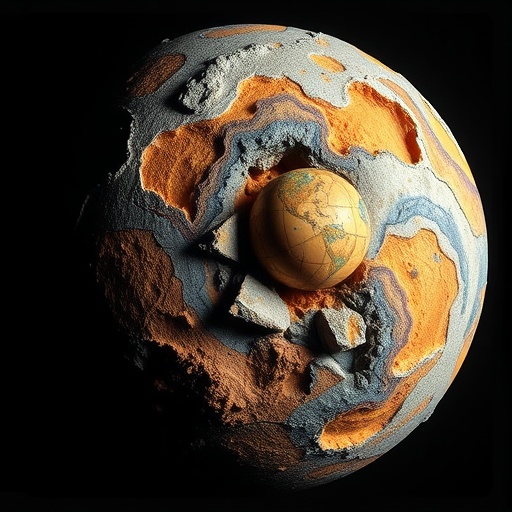The evolution of Earth’s early continental crust has emerged as a cornerstone in understanding planetary habitability, offering crucial insights into the intricate interplay between geological, chemical, and physical processes that govern the Earth’s systems. As the foundation of diverse ecosystems and the cradle of life, continental crust supports the myriad interactions among the atmosphere, hydrosphere, and biosphere. Yet, uncertainties persist regarding its formation, largely due to the contentious debate surrounding the relative influence of internal versus external energetic drivers during the planet’s formative years.
In recent discussions highlighted in significant research, the dichotomy between internal and external forces shaping the crust becomes apparent. Internal drivers, such as plate tectonics and their mechanisms including subduction and delamination, play a pivotal role in the distribution and modification of crust material. These processes are deeply ingrained in the geological activity that has sculpted the surface of the Earth over billions of years. Plate tectonics, responsible for the movement of Earth’s lithosphere, ensures the recycling and renewal of crustal material, thus influencing its ongoing evolution.
Meanwhile, external drivers present another fascinating angle from which to view crustal development. Large meteorite impacts, for instance, have been identified as catalyzers for crust formation, introducing profound topological and compositional changes. By inducing rapid decompression melting of the mantle, these colossal events generate basaltic protocratons—early crustal nuclei that form the building blocks for further crustal evolution. As planetary bodies collide and merge, they not only reshape the surface but significantly alter the geological narrative of Earth’s early history.
On a planet enveloped by water, the subsequent transformation of these protocratons into evolved continental crust further highlights the dynamic nature of early geological processes. Intracrustal differentiation emerges as a key mechanism, allowing for the refinement of the crust’s composition. Through processes such as magmatic differentiation, initial basaltic layers are progressively altered to form more complex granitic structures, which are integral to creating stable continental masses. This transition is vital to developing the hospitable environments necessary for life’s emergence.
Moreover, exploring the interplay of these internal and external factors requires an extensive repurposing of traditional geological methods. Geochemical analyses offer a window into the elemental variety and mineralogical compositions that characterize early crustal formations, while geological surveys provide spatial comprehension of ancient crustal distributions. Geophysical techniques, such as seismic imaging and gravitational studies, further unravel the depth and structure of crustal layers, unveiling secrets buried beneath kilometers of sediments.
Future research endeavors are poised to deepen our understanding of Earth’s formative processes, necessitating a broader temporal and spatial perspective. By examining variations on scales that span seconds to millions of years, investigators can glean insights into the long-term patterns that govern mantle overturn rates and impact flux. Such comprehensive investigation will bridge gaps in knowledge, facilitating a more integrated view of early Earth processes and their implications for habitability.
Colleagues are encouraged to consider an array of methodologies and data sources to synthesize findings that reflect the complexity of Earth’s early crustal history. The narratives etched in rocks can reveal a wealth of information, underscoring the need to take an interdisciplinary approach to unraveling the puzzle of Earth’s geological evolution. Investigating these profound interactions will shine a light on critical phases that shaped not only our planet but potentially other terrestrial bodies in the cosmos.
The discussions surrounding Earth’s continental crust evolution also open discourse regarding potential analogs on exoplanets. As the search for extraterrestrial life intensifies, insights gained from Earth’s geological past could inform our understanding of other planets’ capacity for life. Investigating whether similar processes occurred on bodies within our solar system and beyond could revolutionize our astrobiological contexts, revealing the enigmatic processes that may engender habitability elsewhere.
As researchers continue to dissect the complex facets of Earth’s crust and its evolution over time, it becomes apparent that lingering questions will challenge scientific communities for years to come. The synthesis of evidence from geological, geochemical, and geophysical data will illuminate the pathways through which our geological landscape has transformed, thereby enriching our understanding of planetary science. Ultimately, the quest to delineate the history of the Earth’s early crust serves as a potent reminder of the delicate balance required to sustain life.
As studies advance, their implications extend toward practical applications in understanding Earth’s resilience and adaptability. The lessons learned from Earth’s crustal history may also inform strategies aimed at addressing contemporary geological challenges such as climate change and resource depletion. By reflecting on the planet’s past, we gather the knowledge necessary to cultivate a sustainable future, bridging the ancient with the modern.
In summary, the evolution of Earth’s early continental crust stands as a beacon of scientific inquiry, beckoning us to delve deeper into the dynamic processes that define our planet. By embracing the complexities of internal and external drivers, and engaging in interdisciplinary explorations, we inch closer to unveiling the mysteries that lie within Earth’s geological narrative. As we progress, the foundational knowledge gained from understanding these processes will undoubtedly shape our future endeavors in planetary science and beyond.
Subject of Research: The evolution of Earth’s early continental crust
Article Title: The evolution of Earth’s early continental crust
Article References:
Kirkland, C.L., Johnson, T.E., Brown, M. et al. The evolution of Earth’s early continental crust.
Nat Rev Earth Environ 6, 612–625 (2025). https://doi.org/10.1038/s43017-025-00706-6
Image Credits: AI Generated
DOI:
Keywords: planetary habitability, continental crust, plate tectonics, meteorite impacts, geological evolution, geochemistry, early Earth, crust formation, extraterrestrial life




